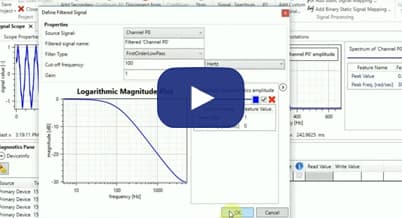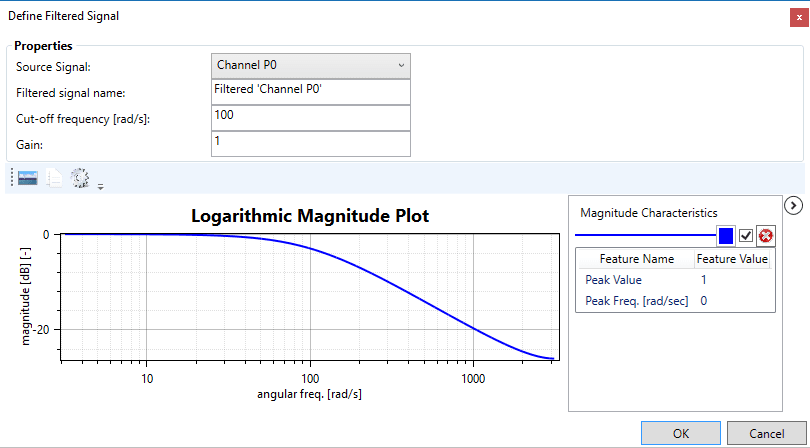

Signal Processing and Analysis
Live signal processing and analysis is performed by means of Dynamic Systems Toolkit (DST). Most of the toolkit’s functionality can be accessed easily by means of the Ribbon Menu. However, it is also possible (and sometimes even easier) to invoke the functionality using the Project Explorer.
Dynamic Systems Toolkit operates with two types of items: signals and spectra. Signals are quantities that depend on time. They can be measured or generated according to some pre-specified functional specification. Spectra are quantities that depend on frequency. A spectrum is always related to some signal, from which it is obtained by means of the Discrete Fourier Transform (more precisely by means of the FFT algorithm).
Some of the supported processing and analysis tools supported within PERUN PowerDesk:
- Defining custom signals from mathematical expressions
- Performing point-wise transformations of signals
- Performing point-wise operations on a pair of signals
- Filtering signals
- Performing Spectral Analysis



Custom Signals

A custom signal is a signal whose values are defined by a custom expression, hence the name. Custom signals are used for a number of reasons. For example, one can use a pre-defined custom signal to represent the desired (reference) value in a control application, or to represent an ideal shape of a certain quantity. These ideal values can then be shown in parallel with signals obtained by measurements.
In fact, all signals within DST hierarchy are equivalent, and can be combined with one another in a number of ways. For example, they can be used in computations to derive further signals. It is therefore possible, for example, to create a signal which will be equal to the difference between the actual (observed, measured) signal and the ideal one. This new signal will be live in the sense that it will updated as soon as one of its arguments changes, for example when new measurements are available.
A custom signal is created by invoking the Add Custom Signal... command from the Main Window Ribbon control. Once the command is invoked, the Define Custom Signal dialog appears, which enables setting properties of the newly created signal.
Point-wise binary
operations on signals

A custom signal is a signal whose values are defined by a custom expression, hence the name. Custom signals are used for a number of reasons. For example, one can use a pre-defined custom signal to represent the desired (reference) value in a control application, or to represent an ideal shape of a certain quantity. These ideal values can then be shown in parallel with signals obtained by measurements.
In fact, all signals within DST hierarchy are equivalent, and can be combined with one another in a number of ways. For example, they can be used in computations to derive further signals. It is therefore possible, for example, to create a signal which will be equal to the difference between the actual (observed, measured) signal and the ideal one. This new signal will be live in the sense that it will updated as soon as one of its arguments changes, for example when new measurements are available.
A custom signal is created by invoking the Add Custom Signal... command from the Main Window Ribbon control. Once the command is invoked, the Define Custom Signal dialog appears, which enables setting properties of the newly created signal.
Filtering signals

Several types of filtering are supported by Dynamic Systems Toolkit, in particular low-pass and high-pass filters of first and second order.
Higher order filters can be designed by chaining up several low order filters. For example, forth order Butterworth filter can be designed by combining two second order filters with appropriate natural frequency and relative damping.
For each filter the appropriate magnitude frequency plot is presented. The plot shows frequency characteristics of the digital filter used for the implementation, not by the frequency characteristics of the analog prototype. This makes the filter design particularly straightforward, especially in cases where cut-off frequencies need to be placed relatively close to the Nyquist frequency.
Spectral analysis

For any signal within the PowerDesk Workspace it is possible to compute spectrum, by means of FFT algorithm. This is true both for the signals obtained by measurement from the underlying physical device, and for the signals obtained by processing (filtering, point-wise transformations, etc.) As all other DST quantities, the computed spectra are live, meaning that the spectrum is tightly bound to the signal from which it has been computed. As soon as the signal changes, for whatever reason, the spectrum will be re-computed in order to reflect this change.

